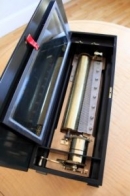a 19th Century Musical Box
Not a “music box”; a “musical box”
Everyone has heard a music box of some sort. But few now know what the full expression of brass cylinders and steel combs can be. Starting with chiming pocket watches in the late 18th century, Swiss craftsmen competed with each other for 100 years to create the finest recorded music in the world. From tiny movements playing one or two songs on 30 or 40 teeth, musical boxes grew to play as many as 24 tunes on combs of 100 or more teeth. The grandeur and musicality of the best of these machines are hard to imagine unless you have heard it in person.
A guided tour of a Herz musical box
How is it possible to create a box that can play eight tunes for an entire room full of guests? Take a look:
The Case
The case protects the movement, but it is also acts as the sounding board of the instrument. The lid is veneered. Other patterns of marquetry and banding are available. The sides of this case are hand painted with a “faux” rosewood pattern, in keeping with the traditional 19th century box it is modeled after. Veneered cases are also available.
Inner Lid
Open the locking lid to expose the winding handle and operating levers. The movement itself remains protected from dust behind a second lid with large glass panel. Normally the movement is played with this second lid closed; it sounds best played this way. Open the second lid to watch the movement up close.
Stopworks
To the right of the inner lid are the stopworks, the controls to the machine. Move the lower start/stop lever to make it play. Whenever you move the lever back to the stop position, the box will finish the tune it is currently playing, then stop. The upper lever is labeled change/repeat. Choose whether to listen to the same tune over or to cycle continuously through all eight tunes.
Winding Handle
The large brass handle winds a pair of massive spring motors. Two motors means twice the playing time. Called a “longue marche” drive, it allows you to listen to the entire program twice without re-winding; about 16 minutes.
The Cylinder
19th century data storage. This 13 inch long cylinder has more than 5000 pins, pressed into tiny holes in the brass. Each pin, located with an accuracy measured in thousandths of an inch, determines the pitch and timing of a single note in one of the eight tunes.
The Comb
The cylinder is the mind of a musical box. The Comb is its voice. Made in a single piece of tool steel, our comb has 92 individually shaped and tuned teeth. No other music box maker in the world uses such a large comb. The range is c2 to c7: five octaves! The comb can play as low as a bassoon and as high as a piccolo. This is what allows a Herz musical box to play orchestral arrangements of works, interweaving many distinct voices.
The Snail Cam
How do you play eight tunes on one cylinder? The trick is in the “snail cam”. Set the change/repeat lever to change, and this tiny cam will rotate 1/8th of a turn after each tune. The cam pushes the cylinder sideways by 0.0175″. This tiny shift allows the slender comb tooth tips to engage with an entirely different set of pins. After the eighth tune, a spring pushes the cylinder back to the first tune, ready to play again.
The Governor
The governor controls the speed of playing. Riding against a synthetic sapphire jewel, the “endless screw” turns at 2000 rpm. The whirring fan blades are what keeps the power of the spring motor in check, allowing the cylinder to turn once a minute.








